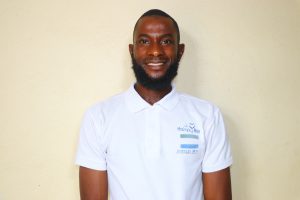In the Gbombana Community, 353 residents scrounge for water daily. There’s a dug well in the community, but it’s highly seasonal, leaving them without accessible water for months at a time. With no other choice, they have to collect water from a distant swamp. As you can imagine, the swamp water is unsafe to consume, and the journey there is treacherous.

A child collecting water from the swamp.
Field Officer Alie Kamra shared, “They only have one primary source, which is [a] protected dug well with a hand pump located on the side of the community. It gets dry, and during that time, there is not enough water coming out from the pump, and it frequently breaks down because of tension on the pump. Due to inadequate and unsustainable water supply in the community, the water users face water challenges. The primary source is not sustainable it gets dry from March to April. During the dry season, the community gathered at the water point, or they formed [a] queue to fetch water. This situation causes them to spend much time at the water point, [and] others will return home with little water. However, the water users also get access to swamp water and it is located far away from the community.”

The well to be rehabilitated.
“The community, left with no choice, [have] to drink this water which causes them to contract waterborne diseases. The community children and women are prone to snake bites because snakes reside in the bush and get close to the road looking for prey. The water source is highly polluted because the community members launder and bathe at the surrounding [area] of the source,” he continued.
38-year-old Fatmata Kamara is a community trader. She shared the hardship she faces every day as she tries to meet her needs and provide for her family.

Fatmata Kamara collects water from the swamp.
“I suffer to fetch water in my village, and the water well in this community does not produce enough water. It produces [a] low quantity of water during the dry season from March to April. Sometimes, I spend [too] much time at the well just to get enough water. When I pump there is not enough water coming out, and the water that is coming out changes color to brown.”
One of the many symptoms of the community water crisis is that it negatively affects Ms. Kamara’s income.
“If there is a breakdown on the pump, I have to go to the swamp to fetch water. This source [is] located far away from my house, so I have to walk tiredly to reach there. I usually walk [a] far distance to reach the swamp well. It is very difficult to fetch water from this source. This situation affects me greatly because I usually produce palm oil to cook at home, and this causes me not to produce large quantities of palm oil,” Ms. Kamara continued.

Drying palm kernels.
Not only is her income consumed by unsafe water, but her health is, too. Ms. Kamara experiences frequent bouts of water-related illnesses, which cause her to lose time to earn an income and care for her family. Progress feels impossible without a safe, accessible water source.

Ms. Kamara carrying water home.
Field Officer Alie Kamara continued, “The swamp well [is] located far away from the community, and it has a footpath. Women and children take great responsibility [for] fetching water home, so the community children and the women are exposed to snake bites because snakes reside in the bush and get close to the road looking for prey. Walking [a] far distance to access water from the swamp well causes the community to get tired, and it will cause them fatigue. They would not be able to make many trips due to the distance. The community gathers at the water point to fetch water. This situation will lead them to quarreling and fighting at the water point.”
“The road leading to the swamp is bushy so I see snakes, which causes me to panic, leading me to fall. During the rainy season, millipedes get into this source sometimes, [so] I had to remove it from the water. All these conditions [are] attached to this source, but still, I must use it for drinking [and] cooking as well. Later, I would get affected with frequent stooling, and I must visit the health facility, which causes me to spend [so] much money,” she concluded.
Rehabilitating the community well will provide Ms. Kamara with a safe and reliable water supply all year round. She won’t have to worry about getting sick with safe drinking water. Her livelihood will have the opportunity to thrive, which means her family’s needs can be met.
Note: Our proposed water point can only serve 300 people per day. We are working with this community to identify other water solutions to ensure everyone can access safe and reliable drinking water.
Steps Toward a Solution
Our technical experts worked with the local community to identify the most effective solution to their water crisis. They decided to drill a borehole well, construct a platform for the well, and attach a hand pump.
Well
Abundant water often lies just beneath our feet. Aquifers—natural underground rivers—flow through layers of sediment and rock, offering a constant supply of safe water. A borehole well is drilled deep into the earth to access this naturally filtered and protected water. We penetrate meters, sometimes even hundreds of meters, of soil, silt, rock, and more to reach the water underground. Once found, we construct a platform for the well and attach a hand pump. The community gains a safe, enclosed water source capable of providing approximately five gallons of water per minute. Learn more here!
Community Education & Ownership
Hygiene and sanitation training are integral to our water projects. Training is tailored to each community's specific needs and includes key topics such as proper water handling, improved hygiene practices, disease transmission prevention, and care of the new water point. Safe water and improved hygiene habits foster a healthier future for everyone in the community. Encouraged and supported by the guidance of our team, a water user committee representative of the community's diverse members assumes responsibility for maintaining the water point, often gathering fees to ensure its upkeep.

 Borehole Well and Hand Pump
Borehole Well and Hand Pump

















